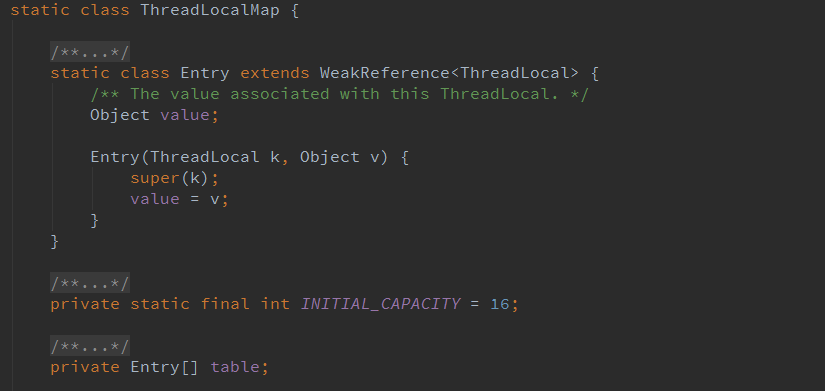浅析ThreadLocal
这是我的第一篇博客,条理不是很清晰,不过还是希望能对大家有所帮助。
首先明确一下这个类的作用,ThreadLocal类是用来为每个线程提供了一份变量的副本,即每个线程的局部变量。每个线程都在自己的栈空间里存有这个变量的值(对象的话就是引用),它们之间是线程隔离的,一个线程对这个ThreadLocal变量做的修改不会被其他线程看见。
下面先看一个例子。
1 import java.util.Random; 2 3 public class ThreadLocalTest { 4 private static final ThreadLocal<Integer> threadId = new ThreadLocal<Integer>(){ 5 protected Integer initialValue() { 6 return 6; 7 } 8 }; 9 10 public static int get(){ 11 return threadId.get(); 12 } 13 14 public static void main(String[] args) { 15 new Thread(new MThread("线程A")).start(); 16 new Thread(new MThread("线程B")).start(); 17 new Thread(new MThread("线程C")).start(); 18 } 19 20 static class MThread implements Runnable{ 21 private String name; 22 public MThread(String str){ 23 name = str; 24 } 25 public void run() { 26 int id = get(); 27 System.out.println("thread "+ name +"'s Id : "+ id); 28 threadId.set(10 * new Random().nextInt(10)); 29 for(int i = 0; i<3; i++){ 30 id = get(); 31 System.out.println("**thread "+ name +"'s Id : "+ id); 32 } 33 } 34 } 35 }
结果:
thread 线程B's Id : 6
**thread 线程B's Id : 60
**thread 线程B's Id : 60
**thread 线程B's Id : 60
thread 线程A's Id : 6
**thread 线程A's Id : 50
**thread 线程A's Id : 50
**thread 线程A's Id : 50
thread 线程C's Id : 6
**thread 线程C's Id : 90
**thread 线程C's Id : 90
**thread 线程C's Id : 90
从上面的结果中我们可以看出每个线程一开始调用get()得到的值都是6,而从输出顺序可知,线程A第一次调用get()时线程B已经在28行set()过threadId,但是A得到的还是6,说明B线程的改动对A是不可见的。
然后我们看看源码中的注释:
大意是说每个线程都有一份自己的,独立于别人初始化的变量副本。下面就用源码中的example来看看是不是独立初始化的。
1 import java.util.concurrent.atomic.AtomicInteger; 2 3 public class ThreadLocalId { 4 private static final AtomicInteger nextId = new AtomicInteger(0); 5 private static final ThreadLocal<Integer> threadId = new ThreadLocal<Integer>(){ 6 protected Integer initialValue() { 7 return nextId.getAndIncrement(); 8 } 9 }; 10 11 public static int get(){ 12 return threadId.get(); 13 } 14 15 public static void main(String[] args) { 16 new Thread(new MThread("线程A")).start(); 17 new Thread(new MThread("线程B")).start(); 18 new Thread(new MThread("线程C")).start(); 19 } 20 21 static class MThread implements Runnable{ 22 private String name; 23 public MThread(String str){ 24 name = str; 25 } 26 public void run() { 27 int id ; 28 for(int i = 0; i<3; i++){ 29 id = get(); 30 System.out.println("thread "+ name +"'s Id : "+ id); 31 } 32 } 33 } 34 }
结果:
thread 线程A's Id : 1
thread 线程A's Id : 1
thread 线程C's Id : 2
thread 线程C's Id : 2
thread 线程B's Id : 0
thread 线程B's Id : 0
thread 线程B's Id : 0
thread 线程A's Id : 1
thread 线程C's Id : 2
从结果中可以看出每个线程的值都是不同的,这就是因为它们是独立初始化的。因为它们第一次调用get()时如果之前没有set()过值或remove()过,则会调用initialValue()方法来初始化值,而这个方法在第6行中进行了覆盖,每次都是返回nextId的值,而nextId每次取完值都会自增,所以每个线程得到的值都会不同。上面的循环3次是为了说明源码注释中的这句:remains unchanged on subsequent calls,后续调用会返回不变的值(当然前提是期间没有通过set()改变过值。。)。
这从get()的源码中可以看出:
public T get() { Thread t = Thread.currentThread();
ThreadLocalMap map = getMap(t); if (map != null) { ThreadLocalMap.Entry e = map.getEntry(this); if (e != null) return (T)e.value; } return setInitialValue(); }
首先会得到当前调用get()方法的线程对象,然后通过getMap()方法获取到与这个线程绑定的ThreadLocalMap对象,下面是getMap()的实现
ThreadLocalMap getMap(Thread t) { return t.threadLocals; }
很简单,就是获取Thread类的成员变量 ThreadLocal.ThreadLocalMap threadLocals = null; 在Thread类中默认为null,接上面的,当Map为空时,就调用setInitialValue();
private T setInitialValue() { T value = initialValue(); Thread t = Thread.currentThread(); ThreadLocalMap map = getMap(t); if (map != null) map.set(this, value); else createMap(t, value); return value; }
而在setInitialValue()中,调用了覆盖后的initialValue()取得一个值给value,刚刚是因为Map为null而调的这个方法,所以就会执行 createMap(t, value);而这个方法就是new一个ThreadLocalMap对象赋值给参数t线程,构造参数第一个this是Threadlocal对象,用来在Entry中对应着一个value。
void createMap(Thread t, T firstValue) { t.threadLocals = new ThreadLocalMap(this, firstValue); } ThreadLocalMap(ThreadLocal firstKey, Object firstValue) { table = new Entry[INITIAL_CAPACITY]; int i = firstKey.threadLocalHashCode & (INITIAL_CAPACITY - 1); table[i] = new Entry(firstKey, firstValue); size = 1; setThreshold(INITIAL_CAPACITY); }

可以看到ThreadLocalMap中持有一个Entry的数组,而每一个Entry里就有一个ThreadLocal对应着一个value值,再结合get()的源码就可以知道大体思路就是:threadLocal变量的值的获取是首先找到当前线程对象,然后在取得这个线程对象的成员变量threadLocalMap,然后再通过threadLocalMap中的Entry[]取得这个当前ThreadLocal对应的Entry对象,然后Entry.value就得到了最终的值。至于怎么找到当前Thread对应的Entry对象就是下面的代码:
1 ThreadLocalMap(ThreadLocal firstKey, Object firstValue) { 2 table = new Entry[INITIAL_CAPACITY]; 3 int i = firstKey.threadLocalHashCode & (INITIAL_CAPACITY - 1); 4 table[i] = new Entry(firstKey, firstValue); 5 size = 1; 6 setThreshold(INITIAL_CAPACITY); 7 } 8 9 private Entry getEntry(ThreadLocal key) { 10 int i = key.threadLocalHashCode & (table.length - 1); 11 Entry e = table[i]; 12 if (e != null && e.get() == key) 13 return e; 14 else 15 return getEntryAfterMiss(key, i, e); 16 }
在第4行放入的时候就是通过ThreadLocal的成员threadLocalHashCode按位与上Entry数组初始化容量-1获得的下标,所以getEntry()时,第10行先得出下标i,再table[i]就能获取得到Entry了。
最后用自己的话说就是:每个线程都有一个ThreaLocalMap变量,这个Map里面有一个Entry数组,里面保存了很多个ThreadLocal和Value的映射,当你调用get()时,发现线程没有ThreadLocalMap就创建一个ThreadLocalMap,发现Entry数组里没有找到这ThreadLocal对应的Entry就创建一个Entry,在把值(这个值的获取就是在那个initialValue里面)放进去就好了,最后返回这个值。由此可知每个线程都是有用一块空间来保存这个变量的,所以是线程隔离的,互不干扰的。
至于set()方法其实是类似的,看源码就能知道了。
remove()方法提供主动删除不再使用的threadLocal对应的Entry,这样能避免出现内存泄漏。
在getEntry()中也有调用getEntryAfterMiss()来保障能清理掉stale(陈旧)的Entry,能在很大程度上解决内存泄漏问题。

这里说只要线程还存活,都有持有一个隐式的引用到threadLocal变量,这个引用链为:thread->threadLocalMap->Entry->threadLocal,当线程结束后,其所有的线程局部实例的副本都会被GC回收(除非还存在其他的引用到这些副本)。
非常感谢你能看到最后,如果有什么意见或建议,欢迎大家指出,我会积极改进的。



 浙公网安备 33010602011771号
浙公网安备 33010602011771号